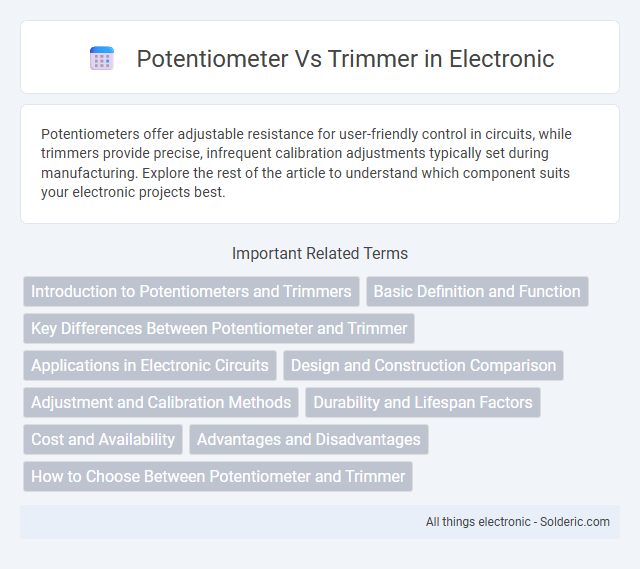Potentiometers offer adjustable resistance for user-friendly control in circuits, while trimmers provide precise, infrequent calibration adjustments typically set during manufacturing. Explore the rest of the article to understand which component suits your electronic projects best.
Comparison Table
| Feature | Potentiometer | Trimmer |
|---|---|---|
| Definition | Adjustable three-terminal resistor used to control voltage | Small adjustable resistor for fine-tuning circuits |
| Size | Larger, designed for manual adjustment | Compact, designed for occasional adjustment |
| Adjustment Frequency | Frequent manual adjustments | Infrequent, set during calibration |
| Mounting Type | Panel-mounted or PCB-mounted | Primarily PCB-mounted |
| Usage | Volume controls, tuning | Calibration, trimming circuits |
| Cost | Higher cost | Lower cost |
| Durability | Designed for repeated use | Less durable, used sparingly |
Introduction to Potentiometers and Trimmers
Potentiometers and trimmers are essential variable resistors used to adjust voltage and current in electronic circuits for precise control. Potentiometers typically offer manual adjustments accessible to users for tuning devices, while trimmers are compact, often set during manufacturing or calibration for fine-tuning. Understanding these components helps you optimize circuit performance and ensure accurate electronic measurements.
Basic Definition and Function
A potentiometer is a three-terminal variable resistor used to adjust voltage levels in circuits, typically for controlling parameters like volume or brightness. A trimmer is a smaller, adjustable resistor intended for fine-tuning and calibration within electronic devices, often set during manufacturing or maintenance. Both devices vary resistance, but potentiometers are user-accessible controls while trimmers are designed for infrequent adjustment.
Key Differences Between Potentiometer and Trimmer
Potentiometers are adjustable resistors designed for frequent manual adjustments and are typically larger with a rotating shaft, while trimmers are compact, meant for infrequent calibration, and adjusted using a screwdriver slot. Potentiometers usually offer higher power ratings and are used in user interfaces, whereas trimmers provide fine-tuning in circuit boards with lower power handling. The primary difference lies in their application scope: potentiometers enable dynamic control, whereas trimmers serve as set-and-forget components for precise circuit calibration.
Applications in Electronic Circuits
Potentiometers are widely used in volume controls, tuning circuits, and adjustable power supplies for precise resistance adjustment. Trimmers are typically employed in calibration settings, frequency adjustments, and fine-tuning within circuit boards to ensure optimal performance. Both components provide variable resistance, but potentiometers are designed for frequent user adjustments while trimmers are intended for occasional or one-time calibration.
Design and Construction Comparison
Potentiometers typically feature a larger, robust design with a rotary or slider mechanism enclosed in a sturdy housing, making them suitable for frequent adjustments in various electronic circuits. Trimmers are smaller, compact devices designed for infrequent tuning, often employing a screw-adjustable wiper on a resistive track, optimized for space-constrained applications. The construction of potentiometers emphasizes durability and user accessibility, whereas trimmers prioritize size efficiency and precise calibration within tight enclosures.
Adjustment and Calibration Methods
Potentiometers offer smooth, continuous adjustment through a rotating knob or slider, making them ideal for settings requiring frequent and precise user control, while trimmers provide fine-tuning via a small screw, designed primarily for infrequent calibration in circuit boards. Calibration using a potentiometer allows real-time manual changes, enabling quick adaptation to varying conditions, whereas trimmers require careful adjustment with tools during production or maintenance to set fixed parameters. Understanding these differences helps you select the appropriate component for accurate adjustment and reliable calibration in your electronic design.
Durability and Lifespan Factors
Potentiometers typically offer higher durability and longer lifespan due to their robust construction and suitability for frequent adjustments in harsh environments. Trimmers, designed for infrequent calibration, feature more delicate components that may wear out faster under constant use. Your choice depends on the application's need for durability versus precision adjustment stability over time.
Cost and Availability
Potentiometers typically cost more than trimmers due to their larger size and higher power ratings, making them suitable for frequent adjustments. Trimmers are inexpensive, compact, and primarily designed for calibration settings, often limiting their availability in higher wattage options. You can easily find potentiometers in various retail outlets and online stores, while trimmers may be more commonly available through specialized electronic component suppliers.
Advantages and Disadvantages
Potentiometers offer smooth, continuous adjustment and are ideal for frequent manual tuning, providing precise control in volume and tone settings. Trimmers, while more compact and cost-effective, are designed for infrequent calibration and often require a screwdriver, making them less convenient for regular user adjustments. Your choice depends on whether you need ease of use and frequent access (potentiometer) or a low-cost, stable setting for occasional calibration (trimmer).
How to Choose Between Potentiometer and Trimmer
Choosing between a potentiometer and a trimmer depends on the application's requirement for adjustability and precision. Potentiometers are suitable for user-controlled, frequent adjustments in audio or lighting controls, while trimmers provide stable, fine-tuning calibration during circuit setup. Consider factors like size constraints, adjustment frequency, and environmental stability when selecting the appropriate variable resistor.
Potentiometer vs trimmer Infographic

 solderic.com
solderic.com